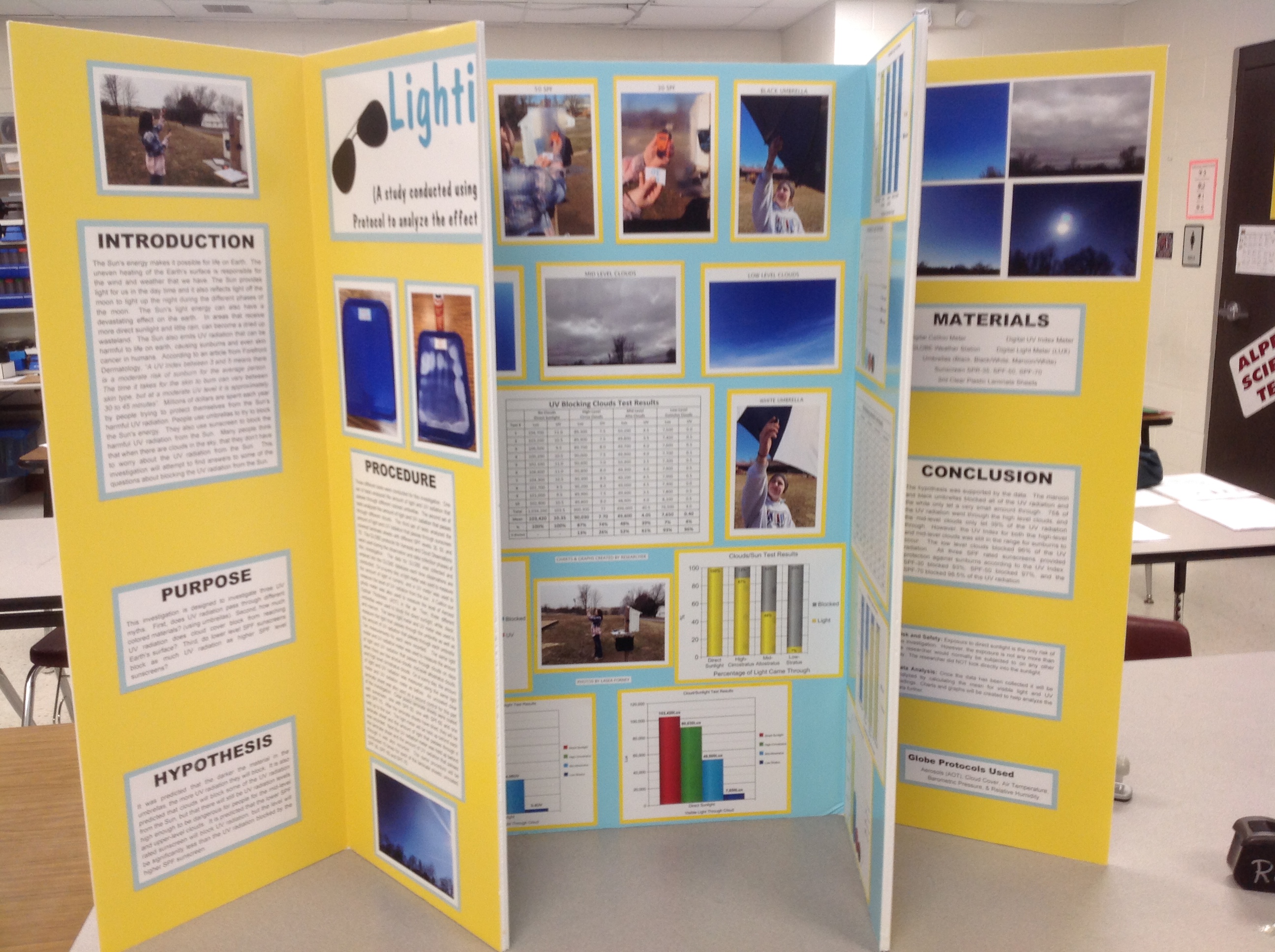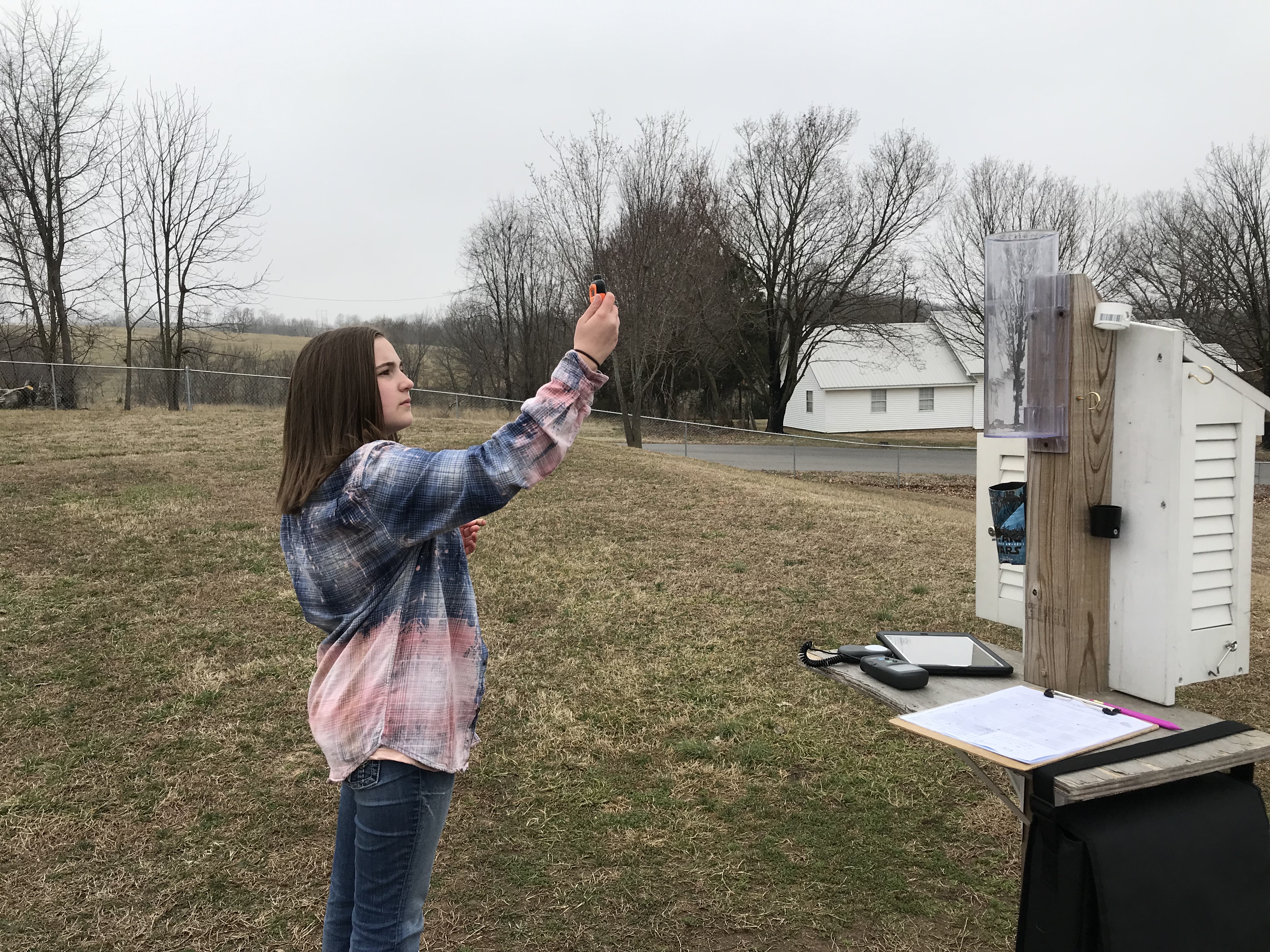Lighting Up? - Grade 6 - 2020 SRS - 2020 SRS
GLOBE Breadcrumb
- Home>
- 2020 SRS
Open social media sharing options menu
 Share
Share
GLOBE Side Navigation
Site Name
2020 Student Research Symposium (SRS)
Message Boards
Project Title: Lighting Up? - Grade 6
School Name: Alpena Elementary/Middle School
Teacher Name: Roger Rose
Student Name: Nella Forney
Grade Level: 6
Project Description: A study conducted using the GLOBE Aerosol and Cloud Testing Protocol to analyze the effect of clouds and other materials on Visible and UV light
Abstract: This investigation analyzed the amount of light and UV radiation that penetrated different colored umbrellas, different level of clouds, and SPF-30, 50 and 70 sunscreen. It was predicted that the darker umbrella materials would block most of the UV radiation, the clouds would not all block enough to be safe from sunburn, and sunscreens would block the UV radiation.
A light meter and UV meter were used to collect 10 sets of data from sunlight and UV radiation going through white, maroon, black umbrellas; upper-level cirrostratus, mid-level altostratus, low-level stratus clouds; and SPF-30, 50 and 70 sunscreen sprayed on clear laminate sheets. GLOBE data for Clouds, and Aerosols was collected and entered into the GLOBE database for each observation.
Umbrella Tests: Direct sunlight: 104,520Lux, UV Index=10.25; White: 44,160Lux, UV Index=0.5; Maroon: 9,790Lux, UV Index=0.0; Black: 9,790Lux, UV Index=0.0. Cloud Tests: Direct sunlight: 103,420Lux, UV Index=10.35; High-level Cirrostratus: 90,030Lux, UV Index=7.7; Mid-level Altostratus: 49,600Lux, UV Index=4.05; Low-level Stratus: 7,650Lux, UV Index=0.4. Sunscreen Tests: Direct sunlight: 97,120Lux, UV Index=9.65; Direct Sunlight through Clear Laminate Sheet: 92,320Lux, UV Index=8.6; SPF-30: 88,230Lux, UV Index=0.7; SPF-50: 88,050 Lux, UV Index=0.3; SPF-70: 90,270Lux, UV Index=0.15.
The hypothesis was supported by the data. Maroon and black umbrellas blocked all the UV radiation and white 95%. 75% & of UV radiation went through high-level clouds, and mid-level clouds let 39% through. Low-level clouds blocked 96% of the UV radiation. The sunscreens all worked well; SPF-30 blocked 93%, SPF-50 blocked 97%, and SPF-70 blocked 98.5% of the UV radiation.
Atmosphere Protocols: Aerosol – AOT, Air Temp, Barometric Pressure, Clouds, Relative Humidity
Language: English
Video URL: https://youtu.be/3-xPSnrIpbc

![]()

![]()
School Name: Alpena Elementary/Middle School
Teacher Name: Roger Rose
Student Name: Nella Forney
Grade Level: 6
Project Description: A study conducted using the GLOBE Aerosol and Cloud Testing Protocol to analyze the effect of clouds and other materials on Visible and UV light
Abstract: This investigation analyzed the amount of light and UV radiation that penetrated different colored umbrellas, different level of clouds, and SPF-30, 50 and 70 sunscreen. It was predicted that the darker umbrella materials would block most of the UV radiation, the clouds would not all block enough to be safe from sunburn, and sunscreens would block the UV radiation.
A light meter and UV meter were used to collect 10 sets of data from sunlight and UV radiation going through white, maroon, black umbrellas; upper-level cirrostratus, mid-level altostratus, low-level stratus clouds; and SPF-30, 50 and 70 sunscreen sprayed on clear laminate sheets. GLOBE data for Clouds, and Aerosols was collected and entered into the GLOBE database for each observation.
Umbrella Tests: Direct sunlight: 104,520Lux, UV Index=10.25; White: 44,160Lux, UV Index=0.5; Maroon: 9,790Lux, UV Index=0.0; Black: 9,790Lux, UV Index=0.0. Cloud Tests: Direct sunlight: 103,420Lux, UV Index=10.35; High-level Cirrostratus: 90,030Lux, UV Index=7.7; Mid-level Altostratus: 49,600Lux, UV Index=4.05; Low-level Stratus: 7,650Lux, UV Index=0.4. Sunscreen Tests: Direct sunlight: 97,120Lux, UV Index=9.65; Direct Sunlight through Clear Laminate Sheet: 92,320Lux, UV Index=8.6; SPF-30: 88,230Lux, UV Index=0.7; SPF-50: 88,050 Lux, UV Index=0.3; SPF-70: 90,270Lux, UV Index=0.15.
The hypothesis was supported by the data. Maroon and black umbrellas blocked all the UV radiation and white 95%. 75% & of UV radiation went through high-level clouds, and mid-level clouds let 39% through. Low-level clouds blocked 96% of the UV radiation. The sunscreens all worked well; SPF-30 blocked 93%, SPF-50 blocked 97%, and SPF-70 blocked 98.5% of the UV radiation.
Atmosphere Protocols: Aerosol – AOT, Air Temp, Barometric Pressure, Clouds, Relative Humidity
Language: English
Video URL: https://youtu.be/3-xPSnrIpbc


Attachments:
Hello, my name is Yunqian and I am a research scientist from the University of Colorado, Boulder. I'm also a GLOBE GISN member.
Your presentation is very engaging. I like your confidence. I like that you point to each figure and explain what they are. You have very nice communication skills.
The tests of the umbrellas and the UV blockers are well-designed and the conclusions are convincing. Now I know I should carry a black umbrella and UV70 for our sunny Colorado weather. Thank you!
The minor concern from me is about clouds. I don't think your low cloud picture is the low cloud. They look like high cirrus clouds to me. In addition to the cloud altitudes, their thicknesses can also impact the AOT you measure. In another word, optically thin clouds block less sunlight than thick clouds.
Your presentation is very engaging. I like your confidence. I like that you point to each figure and explain what they are. You have very nice communication skills.
The tests of the umbrellas and the UV blockers are well-designed and the conclusions are convincing. Now I know I should carry a black umbrella and UV70 for our sunny Colorado weather. Thank you!
The minor concern from me is about clouds. I don't think your low cloud picture is the low cloud. They look like high cirrus clouds to me. In addition to the cloud altitudes, their thicknesses can also impact the AOT you measure. In another word, optically thin clouds block less sunlight than thick clouds.
Hello. My name is Camille Gernhart. I am a geologist with the Arkansas Geological Survey. Here is a link to my bio. I thought your project was well thought out and very relevant to our society. Even my husband and I have debated whether SPF 70 was actually doing anything more than SPF 30. Thanks for settling our debate. I thought you made good use of the graphs. I like how your poster was organized. I was a little confused about the picture of low level clouds. They didn't look very low level. Your research leads me to wonder what the results would've been using an SPF 15 sunscreen since you find that in many lotions and makeup as well as a medium colored umbrella like green or blue. Thank you for a doing such a good job. Good luck!
Hello, my name is Larisa Schelkin, I am a retired petroleum engineer and an engineering R&D specialist. I now work with K-12 educators in a local non-profit Global STEM Education Center (www.globalstemcenter.org) in Massachusetts. I am a GLOBE Partner, GLOBE GISN member and a proud GLOBE educator (https://www.globe.gov/web/larisa.schelkin/home). It is a pleasure "meeting" you and your teacher virtually! I have enjoyed your excellent (virtual) presentation (great video!); it felt like we all are there at the SRS (student research symposium). Thank you for sharing what has inspired you to do this research project! I too feel preventing skin cancer (and sunburns) is very important. You did an excellent job developing your project poster(s)- well organized, well-illustrated and well presented! I like your hypothesis, your attention to data collection/data presentation/data analysis and the GLOBE protocols. I appreciate your passion, your dedication to working on this research project! Great job!










